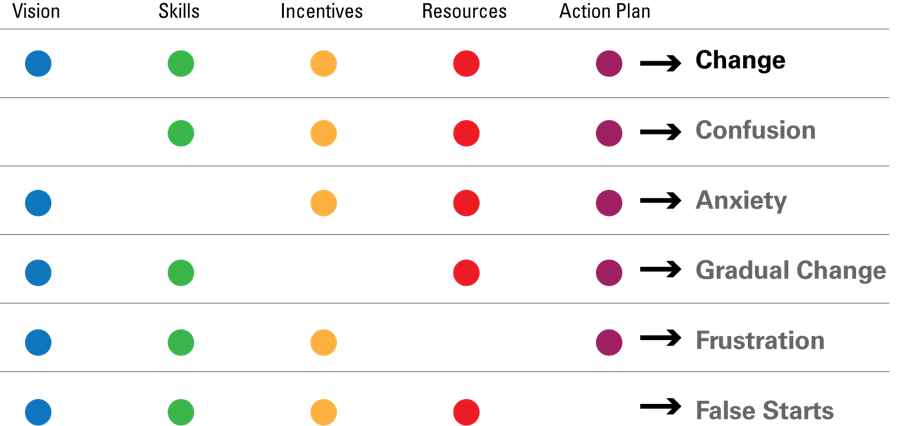The key to successful process improvement and change is commitment from management at all levels in the organization.

A successful change program consists of vision, skills, incentives, resources, and an action plan. All require management support, if not active involvement. When management does not take an active role and only pays lip service to process improvement many different problems occur.
What Does Executive Management Need to Do?
- Executive management needs to provide the vision for process improvement and all management levels need to support the vision. Without the vision or support for the vision, there is confusion.
- These senior leaders also need to staff the team responsible for improving the processes with credible and appropriately skilled and trained individuals. In the absence of a skilled team, there is anxiety.
- Executive management needs to provide incentives for improving the processes. Not necessarily monetary incentives as these can backfire and demotivate people. Recognition for supporting process improvement needs to be equitably applied to teams at all levels in the organization, not individuals. If incentives are absent or inconsistently applied, the best that you can hope for is gradual change.
What Does the Improvement Team Need to Do?
The team responsible for improving the processes needs to accurately estimate the resources (facilities, tools, people, and funds) necessary to make the changes and then clearly communicate this information to the Executive management sponsor. Executive management and all management levels need to support the resource estimates. If not, the lack of sufficient resources can lead to frustration and the old complaint “responsibility with authority.”
And finally, if the team responsible for improving the processes does not prepare an action plan and review it with management for approval, then there will be endless false starts and no progress.
How to Obtain and Sustain Management Commitment
So, how do you obtain and sustain the needed management commitment? It has to start from the top Executive. Otherwise, the process improvement team is faced with trying to push a rope uphill, an exercise in futility. It is the job of the process improvement team to meet with the Executive sponsor and clearly communicate the implications of his or her decision to make improvements. Expectations need to be openly discussed and issues resolved.
The first step is to establish a Management Steering Committee staffed by managers from the different levels in the organization and the lead of the process improvement team to provide guidance, support, and approval of the needed process improvement activities. To be successful, all process improvement efforts need to be treated like a project with a plan, resources, specified roles and responsibilities, schedule, appropriate training, clearly defined outputs, identified and involved stakeholders, measures for monitoring and controlling the effort, an objective evaluation of adherence to the group's processes and plan, and a periodic review of progress with the Management Steering Committee.
The Management Steering Committee needs to know and understand what progress is being made, if the progress is meeting expectations, if the resources they have committed have been put to good use, and if the results support Executive Management’s business goals and objectives. These briefings need to be quantitative based on the data collected and analyzed by the process improvement team, not solely qualitative results. Qualitative results can be argued with, but not so much for quantitative results.
So in summary, commitment means taking responsibility. Process improvement is a team effort involving all management levels, not just the team assigned responsibility for doing the work.
About the Author:
 Henry Schneider is an EmpowerMentor, a seasoned CIO/CTO coach and mentor with over 30 years experience as a systems engineer, project manager, developer, trainer, consultant, and High Maturity Lead Appraiser, including software quality and process improvement services (Quality Circles, TQM, ISO 9000, CMMI, and Operational Excellence) who empowers his clients with the skills, knowledge, and recommendations to resolve complex business process issues.
Henry Schneider is an EmpowerMentor, a seasoned CIO/CTO coach and mentor with over 30 years experience as a systems engineer, project manager, developer, trainer, consultant, and High Maturity Lead Appraiser, including software quality and process improvement services (Quality Circles, TQM, ISO 9000, CMMI, and Operational Excellence) who empowers his clients with the skills, knowledge, and recommendations to resolve complex business process issues.
Henry works with large and small domestic and international companies, providing business integration; change management; program/project management; business processes; software selection, integration, and implementation support; stakeholder management; KPI development and dashboard creation; mission, values, and goals development and facilitation; and quantitative performance management consulting and appraisal services.
Check out his website here, or connect with him on LinkedIn, Twitter, or Facebook.



Add a Comment